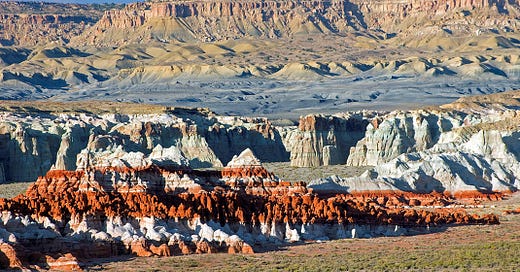Time Worn Wisdom: Erosion as the Brushstroke of Ancestral Artists - Part 4 of 10 LoRaS
TEMJ 20539 - Hopi People, Hopi Mesas, Environmental Harmony, LoRaS, Katsina Dances, Erosion, Cultural Memory, Spiritual Identity, Sacred Altars, Communal Bond
Greetings Fellow Earthmonks,
Welcome to the Earthmonk Journal, your passport to the extraordinary stories of people and places. In each edition of The Earthmonk journal we will explore nature's wisdom and it’s wonders!
Join me as we traverse landscapes of discovery, guided by curiosity, and fueled by passion for the wild. So grab your metaphorical backpack and embark on an unforgettable adventure with me.
The Language of Rocks and Stones
Welcome to a new and enlightening journey within the Earthmonk Journal. Over the coming weeks and months, we will explore a ten-part series entitled "The Language of Rocks and Stones." This series delves into the rich and profound relationships that indigenous peoples around the world have with the geological features of their homelands.
The inspiration for this ten-part series stems from two deeply influential sources.
The first is Yale's Forest Forum speaker series, "Tribal Forestry: Understanding Current Issues and Challenges," which ran from January 18 to April 18, 2024. This remarkable series of lectures opened my eyes to the intricate and multifaceted ways in which indigenous communities manage and steward their forests. The knowledge shared by tribal leaders and forestry experts underscored the importance of understanding and respecting the traditional ecological wisdom that has sustained these lands for generations.
The second source of inspiration comes from my own explorations and interpretations of the landscapes of New England. As I have wandered through these ancient lands, I have been captivated by the Native American ceremonial stonework that dots the region. These enigmatic structures, with their precise arrangements and mysterious purposes, speak to a deep connection between the land and the people who have called it home for millennia. Unraveling the mysteries of these stones has been a personal journey of discovery and reverence, further igniting my passion to share these stories with you.
In "The Language of Rocks and Stones," series we will travel across continents and cultures. Each edition in the series will explore the spiritual, cultural, and ecological significance of geological formations to the indigenous peoples who revere them. We will delve into how these rocks and stones are more than mere physical entities; they are living, breathing parts of a larger cosmology, integral to ceremonies, storytelling, and the very identity of these cultures.
Throughout this ten-part series, we aim to illuminate the profound wisdom embedded in these traditions, highlighting the ways in which indigenous peoples have communicated with and interpreted their natural surroundings. We will uncover how sacred sites are chosen, how rituals and ceremonies are conducted, and how stories and legends have been passed down through generations, all centered around these magnificent geological formations.
Join us as we embark on this journey to understand the "Language of Rocks and Stones." Through the voices of elders, spiritual leaders, and cultural custodians, we will learn to see the world through the eyes of those who have long understood the sacred relationship between the earth and its inhabitants. This series is not just an exploration of geology; it is an invitation to connect more deeply with the spiritual essence of the land and to honor the ancient wisdom that continues to guide us in our stewardship of the earth.
"Erosion is the sculptor of time, revealing the artistry of our ancestors etched in stone." - Stewart Koyiyumptewa

Think about the concept of erosion as a form of artistry. How can the process of wearing away reveal hidden wisdom in your own life?
Hopi Mesas, Arizona, USA (Hopi)
The Hopi mesas, rising from the arid landscape of northeastern Arizona, are not merely geological formations but sacred spaces deeply intertwined with the rich culture of Hopi indigenous history. The sacred and ceremonial perspectives on rocks, stones, and the geology of the mesas carry profound significance for the Hopi people, reflecting their spiritual connection to the land.
Keep reading with a 7-day free trial
Subscribe to The Earthmonk Journal to keep reading this post and get 7 days of free access to the full post archives.



